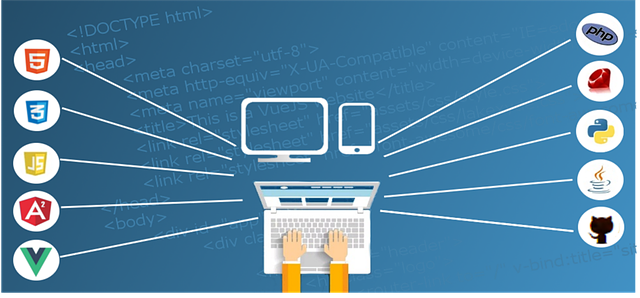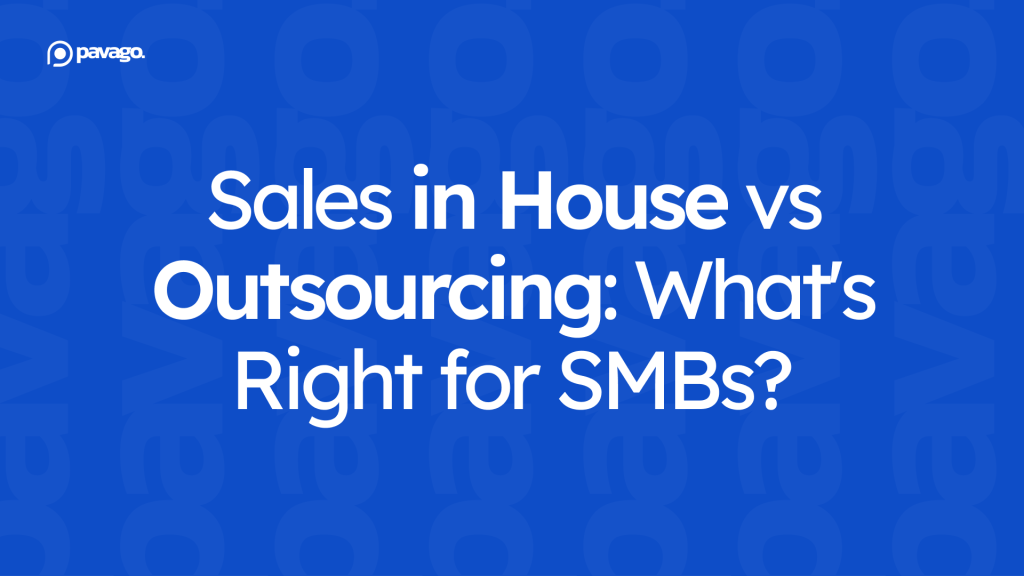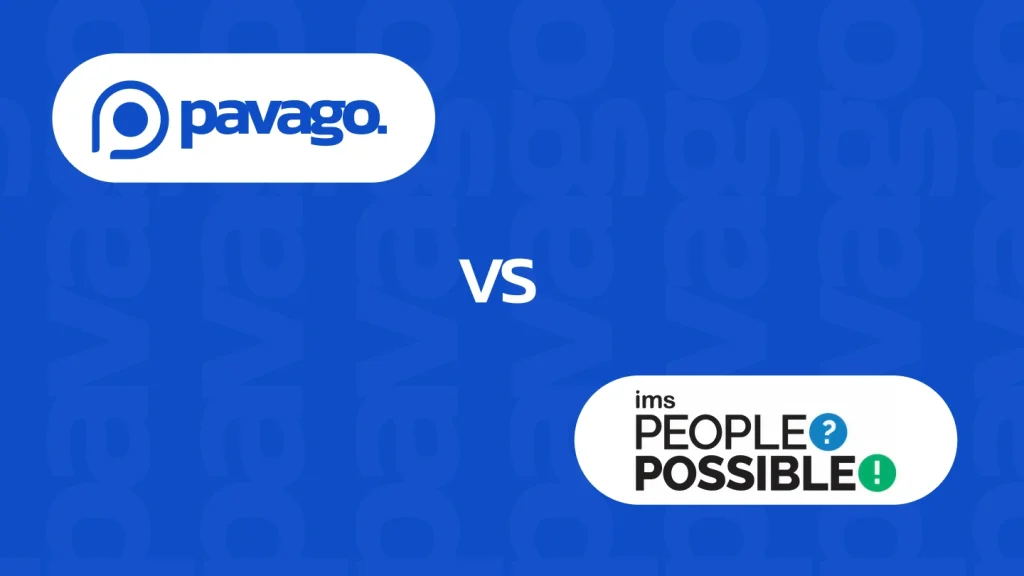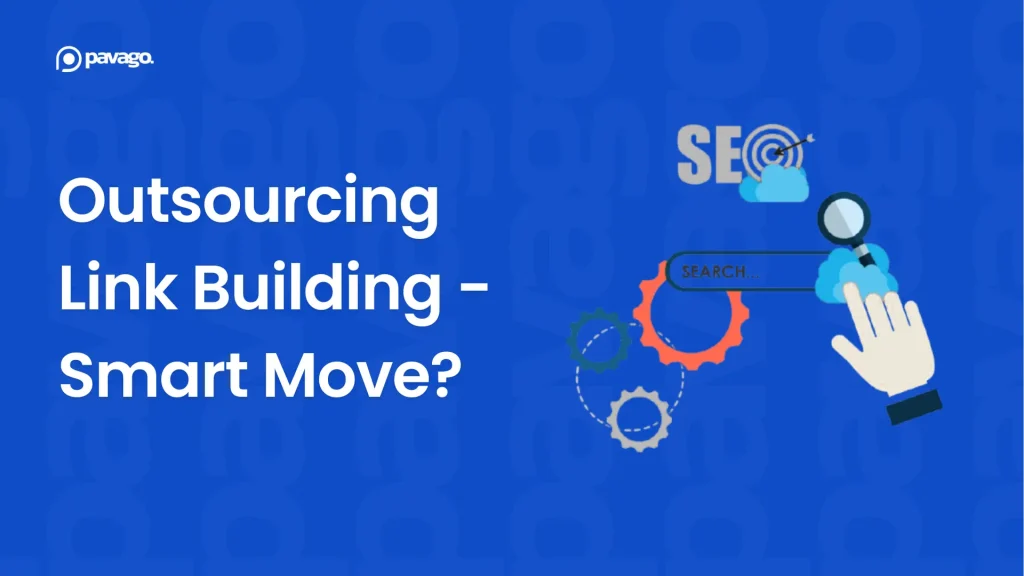Sales are the lifeblood of any business. Choosing between an in-house sales team and outsourcing sales development is critical for any business. The right approach can drive growth and efficiency, while the wrong one might hold you back.
Here’s what we’ll cover in this article:
- What sales development is
- In-house sales team: pros and cons
- Outsourced sales development: pros and cons
- Hybrid sales team: the best of both worlds
- Choosing the right approach for your business
💡 If you're looking for top-notch sales talent without the hefty price tag, Pavago offers a sustainable solution. We help you hire top 1% sales talent for 70% less. With cost-effective pricing and a quick turnaround, we make it easy for SMBs to scale effectively.
What is Sales Development?

Sales development is the process of identifying and nurturing potential customers, turning them into qualified leads ready for the sales team. This involves activities such as prospecting, lead generation, lead qualification, and cold calling. Effective sales development builds a strong pipeline, ensuring your sales team can focus on closing deals rather than finding prospects.
Key Aspects of Sales Development
- Prospecting: Finding potential customers who fit your target audience or market. This involves researching and identifying individuals or companies that might be interested in your products or services. Tools like LinkedIn, CRM software, and industry databases are often used for this purpose. For SMBs, leveraging these tools effectively can help identify high-potential prospects quickly and efficiently.
- Lead Qualification: Assessing which prospects are most likely to convert. This step involves evaluating potential leads based on criteria such as their needs, budget, and decision-making power. The goal is to prioritize leads that have the highest chance of becoming paying customers. For smaller businesses, a streamlined qualification process can save time and resources, ensuring your sales efforts are focused on the most promising opportunities.
- Nurturing Leads: Engaging with prospects to build relationships and move them through the sales funnel. This can include personalized email campaigns, follow-up calls, and providing valuable content that addresses their pain points and interests. Effective nurturing helps keep your brand top-of-mind and prepares leads for a successful handoff to the sales team. SMBs can benefit from automated email campaigns and CRM tools to maintain consistent and personalized communication with leads.
- Cold Calling: Cold calling remains a fundamental aspect of sales development, especially for SMBs aiming to expand their customer base. This direct approach involves reaching out to potential customers who have not previously expressed interest in your products or services. Cold calling can be highly effective if done correctly, as it allows for immediate interaction and feedback. Training your team to handle objections and deliver compelling pitches is crucial for success in cold calling.
👉 You can have the best sales development team with the most advanced software, but without skilled candidates with effective scripts, those tools won't bring the desired results. Pavago not only helps you find the best talent but we also train them so they can stay focused on results from Day-1.
What’s the Importance of Sales Development for SMBs?

Sales development plays a vital role in the success of any business. It acts as the bridge between marketing and sales, ensuring a steady flow of qualified leads into the sales pipeline. Here’s why sales development is crucial:
- Increased Lead Quality: By focusing on identifying and nurturing potential customers, sales development ensures that only the most promising leads reach the sales team. This increases the chances of closing deals and improves overall sales efficiency.
- Shorter Sales Cycles: With a well-developed sales process, leads are more likely to move through the sales funnel quickly. Effective sales development reduces the time it takes from initial contact to closing a sale, allowing your team to close more deals in less time.
- Enhanced Team Efficiency: A dedicated sales development team allows your sales representatives to focus on what they do best – closing deals. By handling the early stages of the sales process, the sales development team frees up valuable time for sales reps to concentrate on converting leads into customers.
- Better Alignment with Marketing: Sales development ensures that the efforts of your marketing team are not wasted. By closely aligning sales development with marketing activities, you can ensure that marketing-generated leads are effectively followed up and nurtured, maximizing the return on your marketing investment.
- Sustainable Business Growth: Consistent and effective sales development helps create a robust and predictable sales pipeline. This stability is crucial for long-term business growth, allowing you to plan and scale your sales operations, with confidence
Outsourced Sales Vs. In-House: Exploring in Detail
Outsourced Sales
Outsourced sales involve hiring external agencies or teams to handle various sales activities. These activities can range from lead generation and prospecting to closing deals. Small and medium-sized businesses (SMBs) often opt for outsourced sales to leverage external expertise and resources without having to build and maintain their own sales team.
In-House Sales
In-house sales refers to building and maintaining a dedicated sales team within your organization. This team is directly employed by your company and works closely with other departments. In-house sales teams are fully integrated into the company culture and are directly managed by the organization’s leadership.
Benefits of Having an In-House Sales Team
An in-house sales team offers several advantages that can significantly impact your business’s success, particularly for SMBs.
- Greater Visibility and Control: One of the primary benefits is greater visibility and control over your sales strategy and operations. With an in-house team, you have direct oversight, allowing for immediate adjustments and ensuring that your sales efforts are closely aligned with your overall business goals.
- Fluid Collaboration: Another advantage is the fluid collaboration that an in-house team facilitates. Internal Sales Development Representatives (SDRs) can integrate seamlessly with the rest of your sales team, promoting better communication and coordination. This close-knit teamwork allows for quick responses to internal changes and feedback, enhancing the overall efficiency of your sales processes.
- Expertise in Technical Products: For SMBs with long sales cycles and complex, technical products or services, having an in-house team can be particularly beneficial. These teams often possess a deep understanding of the technical details and industry-specific needs, enabling them to provide detailed product advice and recommendations tailored to your offerings.
- Deep Product Knowledge: Additionally, internal SDRs typically have a comprehensive knowledge of your products and services, allowing them to offer precise and informed guidance to potential customers, which can be a significant competitive advantage.
Challenges of Building and Maintaining an In-House Sales Team

While the benefits of an in-house sales team are compelling, there are also significant challenges to consider for SMBs.
- Resource-Intensive: Building and maintaining such a team is resource-intensive, requiring substantial investment in recruiting, training, and retaining top talent. According to industry data, the average cost per hire is nearly $4,700, making this process not only costly but also time-consuming. Pavago can cut this down to $329 per hire per month. Continuous effort and resources are needed to ensure the team remains skilled and effective.
- Scalability Issues: Scalability can also be an issue with in-house teams. For SMBs with limited resources, rapidly expanding the team to meet increased demand can be difficult and may not be cost-effective. The expenses associated with salaries, benefits, and training can quickly add up, making it challenging to scale efficiently during periods of fluctuating business needs.
- Need for Rigorous Processes: Additionally, internal SDRs may lack the standardized protocols found in outsourced teams, leading to potential inconsistencies in lead qualification and follow-up processes. Ensuring rigorous and effective processes within an in-house team requires constant improvement and monitoring, which can be a daunting task.
Advantages of Outsourcing Sales Development
Outsourcing sales development can be a viable option for SMBs, providing experience and innovation at a lower cost than setting up a team in-house. Here are some key advantages:
- Cost Savings: Outsourcing can significantly reduce expenses related to salaries, benefits, and office space.
- Expertise and Innovation: Outsourcing brings in remote sales professionals who can offer fresh perspectives and innovative approaches to sales development. These external experts can introduce new strategies and technologies that may not be available internally.
- Flexibility: Outsourced teams can be easily scaled up or down based on your business needs, providing flexibility in managing sales efforts. This adaptability is particularly beneficial for SMBs experiencing fluctuating sales volumes or seasonal demands.
- Adherence to Process: External sales teams often come with established protocols and processes, ensuring a consistent and efficient approach to sales development. This can help maintain high standards and streamline operations.
- Peace of Mind: Trusting an external partner to handle sales development allows you to focus on core business activities, knowing that your sales pipeline is being managed effectively. This delegation can lead to improved overall business performance.
Disadvantages of Outsourcing Sales Development

While there are many benefits, outsourcing sales development also comes with potential drawbacks. It’s important to consider these challenges:
- Quality and Customization: Outsourcing may compromise on the quality and customization of sales efforts. External vendors might not always align perfectly with your specific business needs, leading to a one-size-fits-all approach.
- Understanding Company Goals: Third-party vendors may not fully understand your company’s goals and values. This lack of understanding can lead to misaligned objectives and ineffective sales strategies. Pavago provides complete training and onboarding to help integrate your company’s values into our operations, ensuring alignment with your business goals.
- Communication Challenges: Working with an external team can sometimes lead to communication gaps, which might affect the efficiency of the sales process. Misunderstandings or delays in communication can hinder progress and cause frustration.
- Risk of Misalignment: External teams may not align perfectly with your unique sales strategies and culture. This can result in a disconnect between your internal teams and your outsourced sales partners, affecting overall performance.
Combining In-House and Outsourced Sales Development

Combining in-house and outsourced sales development can offer the best of both worlds, optimizing your sales strategy for maximum efficiency and effectiveness.
Here are some key advantages:
- Strategic Leadership and GTM Experience: By hiring sales leadership with strong go-to-market (GTM) experience to manage your in-house team, you ensure that your sales strategy is guided by seasoned experts. This leadership provides strategic direction and maintains alignment with your business goals.
- Effective Partnership for Prospecting: Leveraging an effective partnership with a sales agency for day-to-day prospecting and cold calling can significantly enhance your lead-generation efforts. Outsourced teams can handle the heavy lifting of prospecting, allowing your in-house team to focus on higher-level sales activities and closing deals. This is particularly beneficial for SMBs with limited resources, as it ensures a steady flow of qualified leads.
- Customer-Centric Roles In-House: Keeping sales roles closest to customers, such as the customer success function, in-house ensures that these critical interactions are managed by individuals deeply familiar with your products and company culture. This fosters strong customer relationships and ensures a consistent customer experience.
While combining in-house and outsourced sales development can be highly effective, it also comes with potential challenges:
- Coordination and Integration: Managing the coordination between in-house and outsourced teams can be complex. Ensuring seamless integration and clear communication is crucial to avoid misunderstandings and ensure both teams work towards common goals. This requires diligent management and regular check-ins to align strategies and objectives.
- Dependency on External Partners: Relying on external partners for key sales functions, such as cold calling and prospecting, can create dependency. This might be risky if the outsourcing partner fails to deliver or if the partnership ends abruptly. Having contingency plans and diversifying outsourcing partners can mitigate these risks.
- Balancing Costs: While outsourcing can save costs, combining it with an in-house team might lead to higher overall expenses if not managed carefully. It’s essential to balance the costs of both in-house and outsourced functions to ensure financial efficiency. Regularly reviewing the cost-benefit ratio of your combined approach helps maintain budget control.
Evaluating Your Organization’s Needs Before Making a Decision

Choosing the right approach for sales development requires a thorough evaluation of your organization’s needs and capabilities. Here are some key factors to consider:
Determine Funding and Sales Infrastructure
Assess whether you have the necessary funding and infrastructure to support a full-stack team of full-time salespeople. This includes evaluating your current resources and future financial projections.
- Create a Detailed Budget Plan: Outline all potential costs, including salaries, benefits, training, and technology investments. Include line items for software licenses, office space, and recruitment fees.
- Evaluate Financial Projections: Look at your projected revenue and growth to ensure you can sustain the investment in a full in-house sales team. Consider whether your cash flow can support the ongoing expenses.
Evaluate Sales and Marketing Budgets
Examine your sales and marketing budgets to ensure they can support robust prospecting and sales activities for in-house resources. Effective sales development often requires substantial investment in tools, training, and personnel.
- Conduct a Cost-Benefit Analysis: Understand the return on investment (ROI) of your current sales and marketing spend. Calculate the cost per lead and cost per acquisition to identify inefficiencies. If reallocating funds might improve efficiency, consider whether outsourcing could provide better value for certain functions.
- Identify Funding Opportunities: Look for areas where reallocating budgets can free up resources for critical sales development activities. For example, cutting back on less effective marketing campaigns to fund a dedicated sales development role.
Consider Relationship-Based Sales
If your sales strategy relies heavily on building relationships and a unique go-to-market motion, it’s crucial to carefully evaluate whether an in-house team can effectively manage these aspects.
- Survey Current Clients: Use surveys or interviews to gather feedback from your current clients about their relationship with your sales team. Assess whether your in-house team is maintaining strong connections and delivering personalized service.
- Analyze Client Interactions: Review CRM data to understand the frequency and quality of interactions between your sales team and clients. Determine if an outsourced team could enhance these relationships through specialized skills or tools.
Assess In-House Managerial Capabilities
Evaluate your in-house managerial capabilities and sales leadership experience. Strong leadership is essential for guiding your sales team and ensuring they meet their targets.
- Perform a Skills Gap Analysis: Assess the current skills and experience of your management team. Identify areas where additional training or new hires are needed. Consider using tools like 360-degree feedback to gather comprehensive insights.
- Consider Leadership Training Programs: If gaps are identified, look into leadership development programs to upskill your existing managers.
When to Outsource Sales Development

Outsourcing sales development can be beneficial for various tactical or strategic reasons. Here’s when you might consider it:
Tactical or Strategic Reasons
Outsourcing can be a strategic move if you need specialized skills or want to quickly ramp up your sales efforts. Here’s how to determine if outsourcing is the right choice:
- Conduct a SWOT Analysis: Identify your internal strengths, weaknesses, opportunities, and threats. This analysis will help you understand where outsourcing can fill gaps or add strategic value. Look for areas where your team lacks expertise or where rapid scaling is needed.
- Set Clear Objectives: Define what you aim to achieve with outsourcing. Whether it’s expanding market reach, improving lead quality, or increasing sales efficiency, having clear goals will guide your outsourcing decision.
- Consider Where to Outsource: It’s important to decide where to outsource your sales talent – nearshore or offshore. Nearshore means outsourcing from Latin America and offshore means outsourcing talent from distant regions such as Pakistan, India, Malaysia, etc.
Evaluate Commercial Knowhow
Assess whether your team or an outsourced partner has the commercial know-how and experience needed to succeed in the go-to-market stage. Here’s how to evaluate this:
- Review Past Performance: Look at your team’s track record in previous go-to-market strategies. If there are gaps, consider outsourcing to gain access to seasoned professionals who bring a wealth of experience and best practices.
- Partner with Experts: If you lack in-house expertise, partner with agencies like Pavago that hire professionals with proven track records for your business.
Consider Time Pressure
If you’re under time pressure and need a fast time to value, outsourcing can accelerate your sales development efforts. Here’s how to manage this:
- Map Out Timelines: Create detailed project timelines and identify critical milestones. Determine where your internal resources might be stretched too thin and where outsourcing can provide the needed speed and efficiency.
- Select Agile Partners: Choose outsourcing partners known for their quick turnaround times and flexibility.
Assess Sales Infrastructure
Determine if your sales infrastructure is adequate to support outsourced sales. Here’s how to ensure your systems are ready:
- Perform an Audit: Conduct a thorough audit of your current sales infrastructure, including CRM systems, communication tools, and data management practices. Identify any gaps or areas that need improvement.
- Ensure Compatibility: Make sure your CRM and other tools can integrate smoothly with the systems used by your outsourced partner. This might involve upgrading software, improving data management practices, or establishing clear communication protocols.
- Streamline Processes: Before outsourcing, streamline your internal sales processes to ensure they align with the workflows of the outsourced team. Clear documentation and standardized procedures will facilitate a smoother integration.
Let Pavago Hire Top Sales Professionals for Your Business

You now have all the information to make an informed decision. Let’s recap some key takeaways:
- Evaluate Your Needs: Assess your organization’s funding, sales infrastructure, and leadership capabilities to determine the best sales development strategy.
- Balance Costs: Understand the cost implications of in-house versus outsourced sales. Outsourcing can save significantly on recruitment costs.
- Leverage Expertise: Use outsourced teams for specialized skills and scaling quickly, allowing your in-house team to focus on core activities.
- Maintain Customer Relationships: Keep customer-centric roles in-house to ensure strong relationships and consistent customer experiences.
- Ensure Flexibility: Combining in-house and outsourced sales development provides flexibility and scalability for various sales activities.
- Assess Time and Infrastructure: Outsourcing can provide quick results under time pressure. Ensure your infrastructure supports seamless integration.
- Strategic Leadership: Hire sales leaders with strong go-to-market experience to manage in-house teams effectively or consider outsourcing experienced leaders.
If you’re looking to hire someone for your in-house sales, consider partnering with Pavago. We offer affordable options with a yearly membership plan at just $500 or unlimited placements at $329 per month per candidate. This innovative pricing model significantly lowers the financial burden on SMBs, enabling you to hire the top 1% talent at 70% less than traditional costs.
✌️ If you’re looking to hire someone for your in-house sales, consider partnering with Pavago. We offer affordable options with a yearly membership plan at just $500 or unlimited placements at $329 per month per candidate.
















